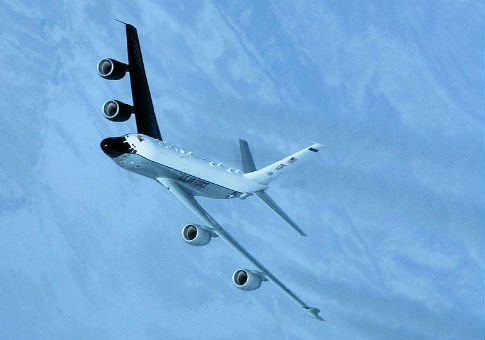A Russian Su-27 jet fighter came within 20 feet of a U.S. RC-135 reconnaissance aircraft over the Black Sea on Monday in Moscow’s latest military provocation involving dangerous aerial encounters.
"On Jan. 25 an RC-135 aircraft flying a routine route in international airspace over the Black Sea was intercepted by a Russian Su-27 in an unsafe and unprofessional manner," Navy Capt. Daniel Hernandez, chief spokesman for the U.S. European Command, told the Washington Free Beacon. "We are looking into the issue."
Defense officials said the Su-27 flew alongside the RC-135, an electronic intelligence-gathering aircraft, and then performed what they said was an aggressive banking turn away from the intelligence jet.
The thrust from the Su-27 "disturbed the controllability" of the RC-135, said one official familiar with details of the incident.
A second official said the reconnaissance aircraft was flying 30 miles from the coast—well within international airspace and far away from any Russian territory—at the time of the encounter.
The Pentagon announced Thursday that it has concluded a flight safety memorandum with Russia after holding a video conference with Russian Defense Ministry officials.
The areas of discussion included air safety over the skies in Syria as well as "the means to avoid accidents and unintended confrontation between coalition and Russian forces whenever the two sides operate in close proximity," Pentagon spokesman Peter Cook said in a statement.
The statement made no mention of Monday’s dangerous aerial encounter.
The Black Sea encounter was the latest in a series of aggressive Russian military activities aimed coercing or harassing U.S. military aircraft and ships in both Europe and Asia.
The provocations are not limited to U.S. forces. On Tuesday, Japan’s Defense Ministry revealed that Japanese interceptor jets were scrambled to chase two Russian Tu-95 Bear bombers that approached the northern end of Japan and flew just outside that country’s airspace in maneuvers described by analysts as unusually close.
Other incidents included a similar near-collision between a Russian fighter and RC-135, a militarized Boeing 707, over the Black Sea on May 30. Around the same time, a Russian Su-24 jet buzzed the destroyer USS Ross in the Black Sea near occupied Crimea.
Earlier, on April 7, another Su-27 flew within 20 feet of an RC-135, this time over the Baltic Sea.
The RC-135 intercept over the Black Sea took place around the same time as a Russian Su-24 jet interceptor buzzed the destroyer USS Ross in the Black Sea, near occupied Crimea.
Navy footage showed the jet made several low-level passes over the Ross.
In October, two Russian Tu-142 bombers made low passes near the aircraft carrier USS Reagan as it sailed in the Sea of Japan near the Korean peninsula.
Navy F-18 jets were scrambled to intercept the bombers during that incident.
And last July 4, two Tu-95 nuclear-capable bombers flew within 40 miles of the California coast and communicated a "happy birthday" message to intercepting U.S. pilots. That incident took place the same day President Obama held a telephone conference with Russian leader Vladimir Putin.
Russian Tu-95 bombers also circumnavigated Guam in December, for the second time in two months. Guam is the U.S. military's major hub and a key facility in the American military rebalance to Asia.
"Much of what Russia is doing today is aimed at generating fear of Russian military power and the possibility of war," said former Pentagon Russia expert Mark Schneider.
"That is broadcast on a daily basis in the state media and through Russian military actions," Schneider added. "Provocations involving aircraft are now common place. Russia also tends to be paranoid concerning foreign espionage and the protection of state secrets."
Adm. Cecil Haney, commander of the U.S. Strategic Command said Russian military activities, including aircraft flights, are an increasing concern as Moscow seeks to reemerge as a world power.
Haney voiced concerns about Russian nuclear-capable bomber flights around the world, and large-scale ground forces nuclear exercises, along with vocal statements threatening the use of nuclear weapons.
Russian military aircraft have been conducting flights in Europe without the use of air-traffic control tracking transponders, a practice Haney called "reckless."
Russia has stepped up aggressive military activities in response to NATO’s deployment of forces closer to Russian borders following Moscow’s military annexation of Ukraine’s Crimea and continuing covert military destabilization of eastern Ukraine.
NATO has increased its force posture with additional military exercises, troop deployments and increased intelligence-gathering to support NATO allies that are threatened by Russian military revanchism.
Russia announced a new military strategy in December that increases the country’s reliance on nuclear forces over conventional troops and weapons.
Russia also is expected to announce a new military doctrine, a senior Russian commander announced on Tuesday.
Maj. Gen. Sergey Chvarkov, deputy chief of the general staff academy said the United States is seeking to weaken Russia and is creating new national security threats to Moscow.
"At the foundation of the negative development of the international situation lie the USA's actions, which in striving for global hegemony intentionally forms global instability to weaken strategic opponents, primarily Russia, creating national security threats to our country," Chvarkov said, according to the state-run RIA Novosti news agency.
Western policies are fomenting global and internal conflicts that have produced the flood of refugees in Europe, Chvarkov said. He added that the West is waging "information war" on Russia.
